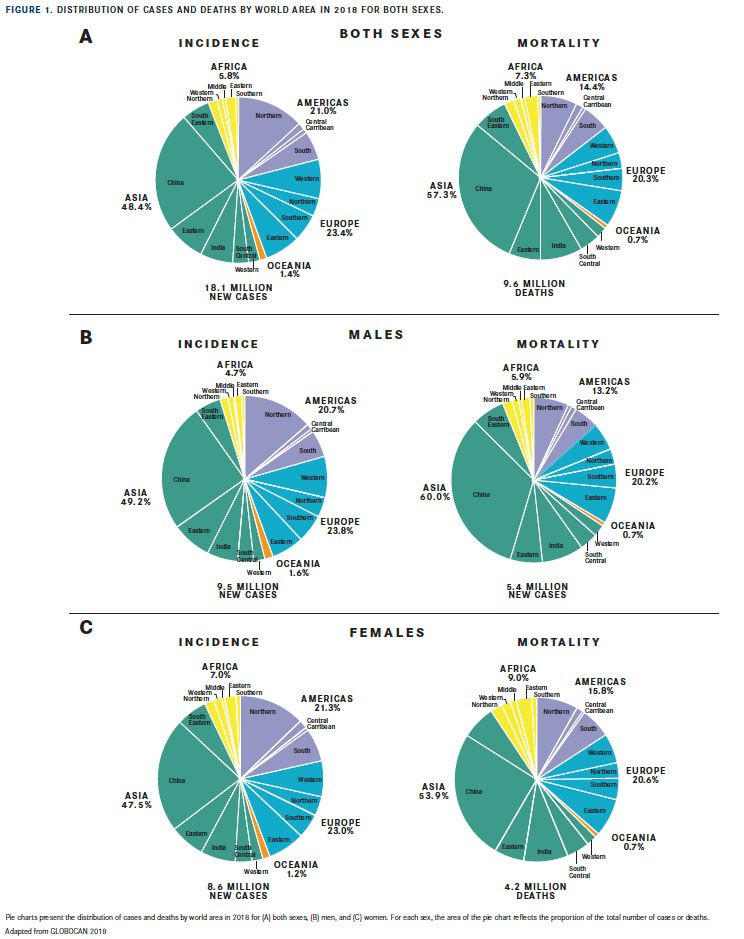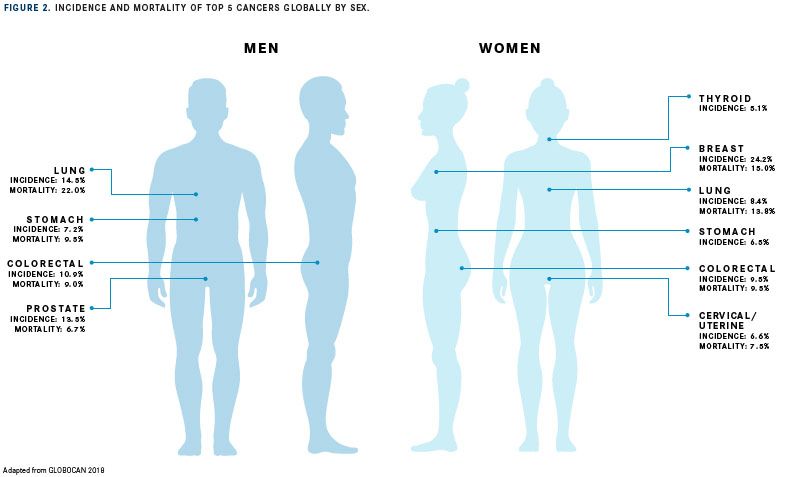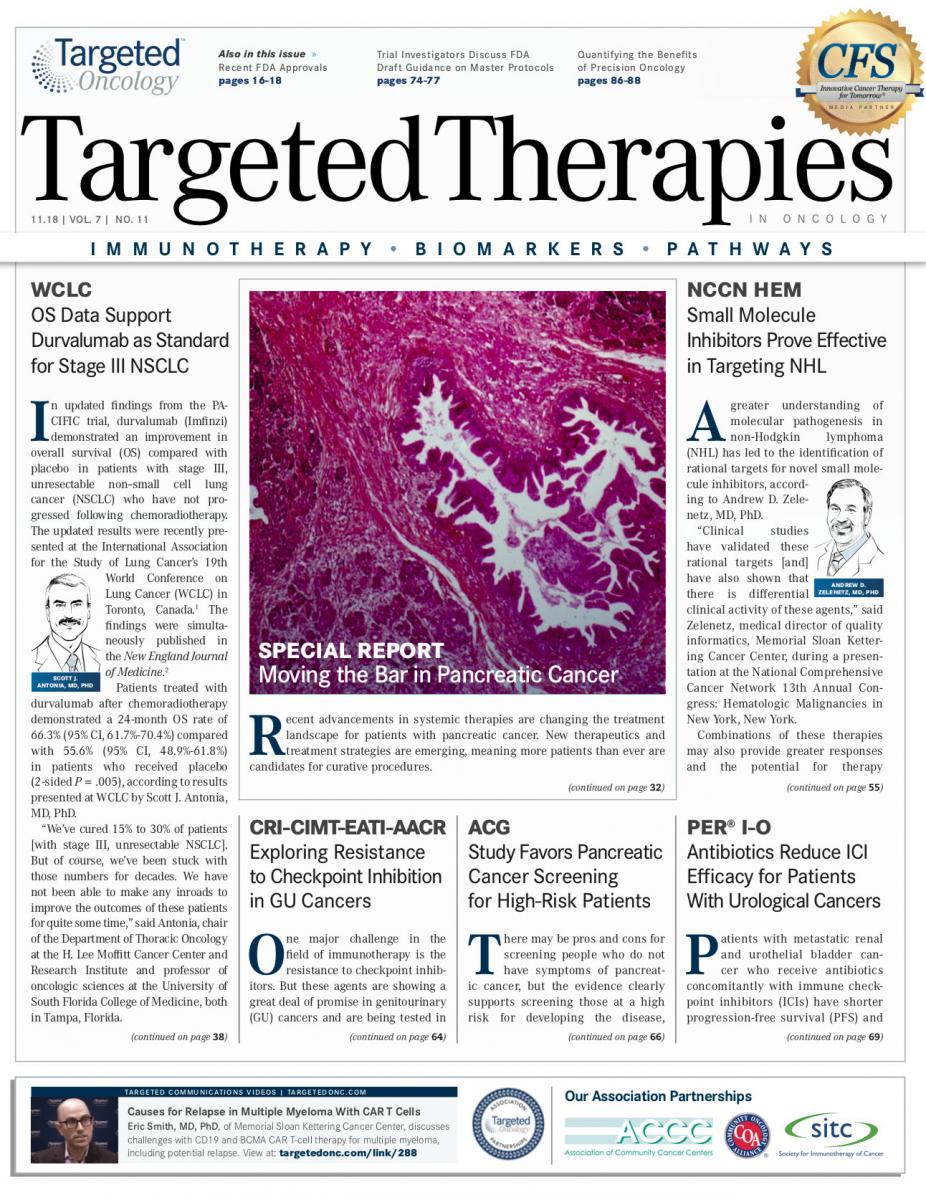Global Cancer Statistics Demonstrate the Complex Interplay Between Societal, Economic, and Lifestyle Factors
In “Global Cancer Statistics 2018: GLOBOCAN Estimates of Incidence and Mortality Worldwide for 36 Cancers in 185 Countries,” Freddie Bray, BSC, MSC, PhD, and colleagues describe the global magnitude and distribution of the disease overall and discuss the associated risk factors and prospects for prevention of the major cancers observed worldwide in their study.
1
“The most frequently diagnosed cancer and the leading cause of cancer death…substantially vary across countries and within each county depending on the degree of economic development and associated social and lifestyle factors,” according to the authors. Previous reports from 2002, 2008, and 2012 focused on a description of cancer incidence and mortality at the global level and an assessment of the geographic variability observed across 20 predefined regions.
Lifestyle factors play a significant factor in incidence and mortality. The investigators state that eliminating or reducing exposure to known lifestyle and environmental risk factors can result in a drop of one-third to two-fifths of new cancer cases. Key factors affecting greater adoption of preventive efforts include a lack of momentum in international efforts to promote and implement primary prevention measures and policy makers’ unawareness of the degree of progress and benefits that prevention brings. The investigators also emphasize the need for population-based national and subnational cancer surveillance data to improve the estimates’ accuracy and inform on-the-ground initiatives in cancer control.
The investigators suggest that these variations reflect differences in the type of exposures and associated cancers and in the availability and use of screening services and diagnostic imaging by region. For example, for skin cancer only, the highest overall incidence rates among both men (571.2 per 100,000) and women (362 per 100,000) are found in Australia/New Zealand. The investigators attribute this to elevated risk but also to an increased detection of skin cancers, particularly nonmelanoma skin cancer, in these countries.
Cancer is a significant cause of morbidity and mortality worldwide, with 18.1 million new cases and 9.6 million related deaths estimated to occur in 2018, according to GLOBOCAN 2018, the report’s data source. In the report, Bray et al summarize the estimated numbers of new cases and deaths by cancer type and point to the variations in the incidence and mortality rates observed in the world regions and individual countries.

FIGURE 1 illustrates the distribution of all-cancer incidence and mortality according to world area for both sexes combined. It is estimated that nearly half of the cases and over half of the deaths will occur in Asia in 2018, in part because close to 60% of the global population resides there. Europe accounts for 23.4% of the total cancer cases and 20.3% of the cancer deaths, although it represents just 9% of the global population, followed by the Americas’ 21% of incidence and 14.4% of mortality. In contrast to other regions, the shares of cancer deaths in Asia (57.3%) and Africa (7.3%) are higher than the shares of incidence (48.4% and 5.8%, respectively) because of the different distribution of cancer types and higher fatality rates in these regions.
Worldwide, the incidence of cancer in men is 20% more than in women (age-standardized risk, 218.6 per 100,000 vs 182.6 per 100,000, respectively). When comparing incidence rates across regions, for men, the rate is 6-fold higher, from 571.2 per 100,000 in Australia/New Zealand to 95.6 per 100,000 in Western Africa. Among women, incidence rates vary nearly 4-fold, from 362.2 per 100,000 in Australia/New Zealand to 95.9 per 100,000 in South-Central Asia.
Similar to incidence rates, mortality from cancer is nearly 50% higher in men compared with women. Death rates per 100,000 persons vary from 171.0 in Eastern Europe to 67.4 in Central America among men and from 120.7 in Mela-nesia to 64.2 in Central America and Eastern Asia (excluding China) among women. Notably, the estimated cumulative risk of dying from cancer among women in 2018 is higher in East Africa (11.4%) than the corresponding risks estimated in North America (8.6%), Northern Europe (9.1%), and Australia/New Zealand (8.1%).

Data pulled from the report indicate that for men and women combined, lung cancer is the most commonly diagnosed cancer, at 11.6% of total cases, and the leading cause of cancer death (FIGURE 2). Of the total cancer deaths, 18.4% are attributable to lung cancer. Among men exclusively, lung cancer has the highest incidence, followed by prostate and colorectal cancers. After lung cancer, liver and stomach cancers had the next-highest mortality rates in men. Among women, breast cancer is the most commonly diagnosed cancer and the leading cause of cancer death, followed by colorectal and lung cancers in incidence and lung and colorectal cancers in mortality; cervical/uterine cancer ranks fourth for both incidence and mortality. Overall, the top 10 cancer types account for more than 65% of newly diagnosed cancer cases and deaths.
The investigators observed the diversity of cancer demonstrated by the variations in the magnitude and profile of the disease between and within world regions. For example, specific types of cancer have a global footprint: lung, female breast, and colorectal cancers make up one-third of the cancer incidence and mortality burden worldwide and are the respective top 3 cancers in terms of incidence and within the top 5 in terms of mortality (first, fifth, and second, respectively). Conversely, 13 types are the most frequent forms of cancer diagnosis or death in 1 or more of the countries studied.
When the global diversity of cancer between men and women is examined, it reveals the differences in leading cancer types. Bray et al state that in men, prostate cancer is the most frequently diagnosed cancer in 105 countries, followed by lung cancer in 37 and liver cancer in 13. The geographic breakdown reveals cancers that represent the most frequent type in heterogenous regions (eg, liver cancer), whereas others tend to cluster in certain high-risk regions (eg, cancers of lip and oral cavity in South Asia or Kaposi sarcoma in Eastern Africa). With regard to mortality, lung cancer is the leading cause of cancer death among men in 93 countries, in part because of its high fatality rate, followed by prostate cancer (46 countries) and liver cancer (20 countries).
In women, breast cancer leads in incidence in the majority of countries (154). After breast cancer, cervical cancer follows in most of the remaining countries (28 of 31) in the report. The mortality profile among women is more heterogeneous, with breast and cervical cancer as the leading causes of cancer death in 103 and 42 countries, respectively, followed by lung cancer in 28 countries.
Reference:
Bray F, Ferlay J, Soerjomataram I, Siegel RL, Torre LA, Jemal A. Global cancer statistics 2018: GLOBOCAN estimates of incidence and mortality worldwide for 36 cancers in 185 countries [published online September 12, 2018]. CA Cancer J Clin. doi: 10.3322/caac.21492.

Survivorship Care Promotes Evidence-Based Approaches for Quality of Life and Beyond
March 21st 2025Frank J. Penedo, PhD, explains the challenges of survivorship care for patients with cancer and how he implements programs to support patients’ emotional, physical, and practical needs.
Read More